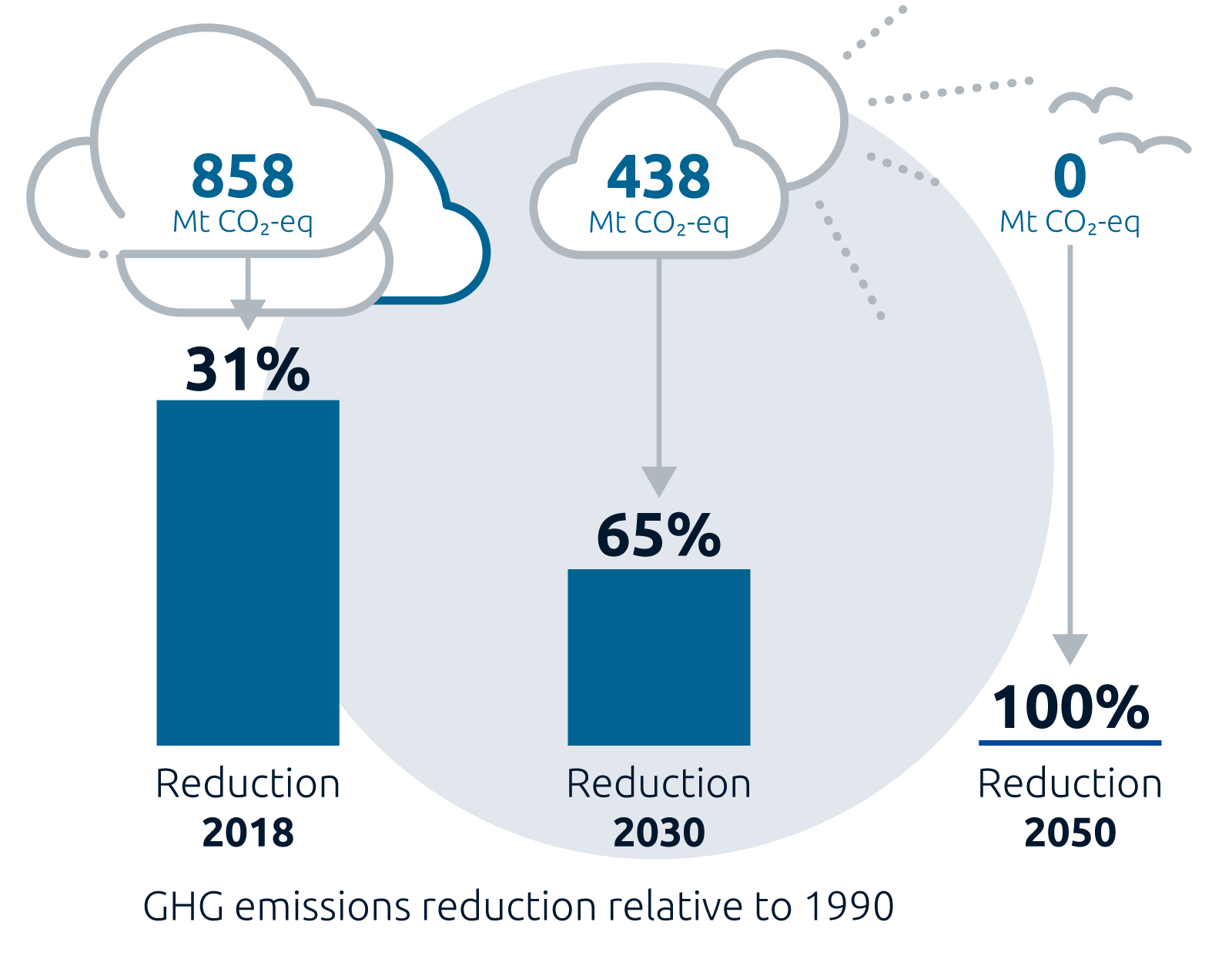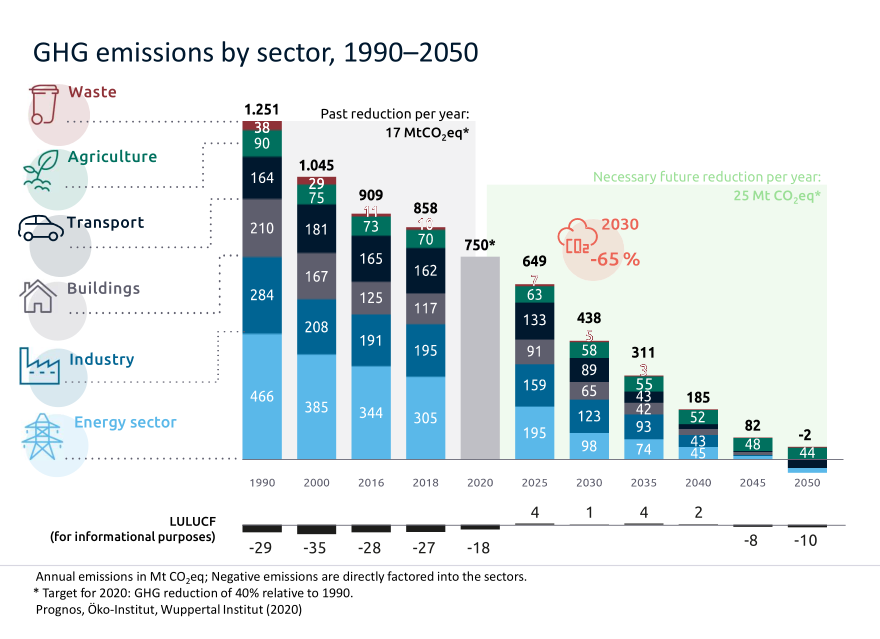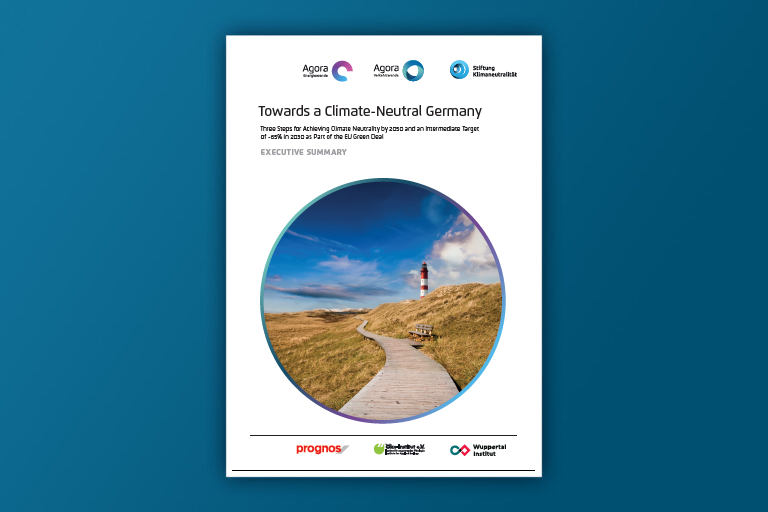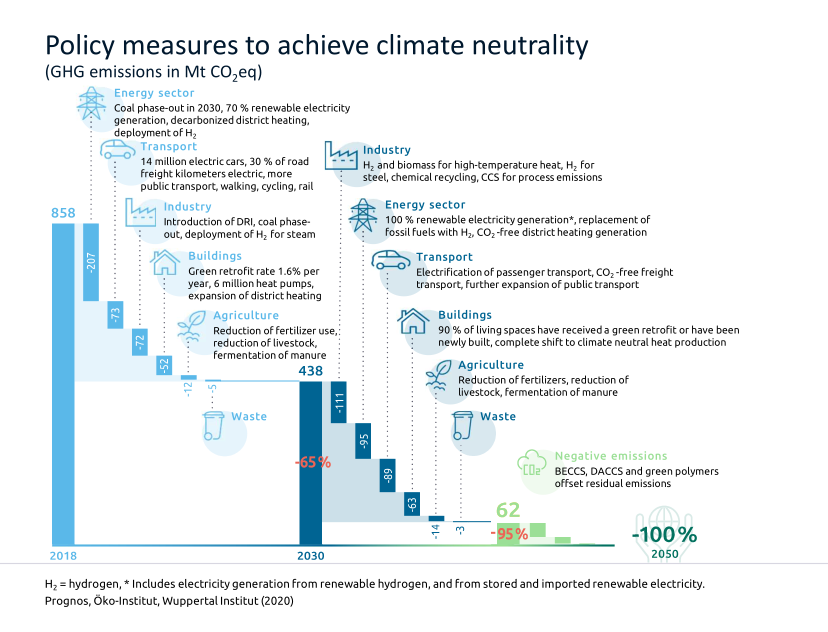The Paris Agreement adopted by world governments at the end of 2015 sets the goal of limiting global warming to well below 2 °C and to pursue efforts to limit the increase to 1.5 °C.
To achieve this, the amount of greenhouse gases emitted globally in the future need to be greatly reduced. The Paris Agreement is intended to ensure that annual global emissions are reduced as fast as possible, thereby stretching the remaining carbon budget and reducing greenhouse gas emissions to net zero in only a few decades.
Both the EU and Germany have committed themselves to achieving climate neutrality by no later than 2050.
Publication “Towards a Climate-Neutral Germany”
How can Germany succeed in creating an economy that does not rely on coal, oil and gas? And what is required for the next ten years? In a large-scale scientific study, we have commissioned a study in cooperation with other think tanks to investigate how Germany can become climate-neutral within three decades.
The study develops scenarios that show how Germany can become climate-neutral by 2050, with cost-effectiveness, adherence to existing investment cycles and acceptance as core criteria.
The scenarios show that this is possible through the consistent application of technologies that are already available today or are well developed. Climate neutrality requires an electricity system based entirely on renewable energies. Road transport and heat supply will largely switch to electricity-based solutions. The efficient refurbishment of existing buildings and the establishment of a hydrogen economy for industry, power generation, shipping and aviation are essential. As a result, by 2050 Germany will have a renewed electricity and transport infrastructure, a sustainable hydrogen industry, a modern building stock and an industry that is at the forefront of future technologies in global competition. Tackled wisely, the path to climate neutrality can become a comprehensive investment and modernization program.
The full version of the study in German can be found here.
Prognos, Öko-Institut, Wuppertal Institut (2020): Towards a Climate-Neutral Germany.
Executive Summary conducted for Agora Energiewende, Agora Verkehrswende and Stiftung Klimaneutralität.
Key findings
1. Germany can achieve climate neutrality by 2050 in three steps while adhering to existing investment cycles. The first step consists of a 65% reduction in emissions by 2030. The second step is the complete transition to climate-neutral technologies, for a total emissions reduction of 95%. The third step is the offsetting of residual emissions through carbon capture and storage.
2. The path to climate neutrality involves a comprehensive investment program comparable in scope to the German economic miracle of the 1950s and 60s. The core elements of the program are the creation of a renewable-based energy sector, mass electrification, a smart and efficient modernization of buildings and the development of a hydrogen economy for the industrial sector. Besides achieving climate neutrality, the program will also improve people’s quality of life by reducing noise and air pollution.

3. An enhanced German reduction target of 65% for 2030, in line with the requirements of the European Green Deal, will require significantly accelerating the green transition in the energy, transport and heating sectors. This includes the complete phase-out of coal by 2030, a 70% share of renewables in electricity generation, 14 million electric cars on the road, 6 million heat pumps, an increase in the green retrofit rate of at least 50% and the use of some 60 TWh of clean hydrogen.
4. The next legislative period will determine how Germany goes about achieving climate neutrality by 2050 and a 65% reduction in GHG emissions by 2030. Government action after the 2021 federal election will be pivotal for future climate policy. Intelligent policy instruments will be needed to modernize Germany’s economy and make it sustainable and resilient. They will also be needed to ensure that the structural changes are as fair and inclusive as possible.
Infographic: GHG emissions by sector, 1990–2050
Prognos, Öko-Institut, Wuppertal Institut (2020)
PDF-file
Infographic: Policy measures to achieve climate neutrality in 2050
Prognos, Öko-Institut, Wuppertal Institut (2020)
PDF-file
Would the path described in the study allow to meet the goals of the Paris Climate Convention?
Yes!
As a nation state, Germany has ratified the Paris Agreement and thus committed itself to the according climate goals (“Limiting global warming to well below 2 degrees and to pursue efforts to limit the increase to 1.5 degrees”). At the same time, the European Union, of which Germany is the largest member state, has also ratified the agreement.
However, only the EU as a group on behalf of all its member states has made a reduction commitment under the agreement (NDC).
In the Paris Agreement, it was agreed that the signatory states would review their reduction contributions for 2030 every five years, starting in 2020. In a first step, the EU decided already at the end of 2019 to become the first climate-neutral continent by 2050. The EU Commission has proposed and the European Council of Heads of State and Government decided on 11 December 2020 to raise the interim target for 2030 from the current 40% GHG reduction compared to 1990 to 55%.
An interim target for 2030 of 55% and climate neutrality by 2050 do not suffice to limit global warming to 1.5 degrees, yet at least to well below 2 degrees. This assumption presupposes that all other signatory states also meet their responsibilities in a comparable manner.
The EU will only be able to meet an increased interim target for 2030 and thus its obligations under the Paris Convention if all its Member States make a fair contribution. What “fair” in this context means will ultimately be decided by the EU institutions. We assume Germany’s contribution to be 65% GHG reductions by 2030.
Extract from the study
Three steps to climate neutrality: Step 1 – Reduce emissions by 65% by 2030
An important step to climate neutrality by 2050 is a 65% reduction of emissions by 2030. Actions taken in the 2020s will decide whether climate neutrality can be achieved by the middle of the century. In the event that the EU raises its reduction target for 2030 from 40 to 55%, Germany will have to reduce its own emissions by about 65% by 2030.
The 2019 Climate Protection Act provides a solid foundation for a further reduction in emissions. The additional reduction potentials relative to previous targets vary across sectors, and some are harder to realize than others. According to the calculations in this study, further reductions in the agriculture and waste sectors are very unlikely, while in the transport and building sectors, additional cuts of 5 Mt each are possible. The greatest potential reductions are in the industry and energy sectors, at 17 Mt and 77 Mt, respectively.
The energy sector has the potential to cut emissions by 207 Mt CO₂eq by 2030, or 77 Mt CO₂eq more than the sector target established in the Climate Protection Act. The primary means for achieving the additional reductions is an accelerated phase-out of coal (2030 instead of 2038) and the increased expansion of renewable capacity in electricity generation. The use of hydrogen for fueling power stations and CHP plants starting in the late 2020s will also contribute to the decline. A phase-out of coal by 2030 will likely occur in the context of tightened EU reduction targets (from 40 to 55%) and adjustments to the EU ETS, largely due to the changing market conditions for coal-fired power generation.
Growing electrification in all sectors will increase electricity consumption by 51 TWh, or 9%, relative to 2018. In 2030, renewable energy will make up around 70% of gross electricity consumption. This will require increasing capacities in offshore wind to 25 GW, in onshore wind to 80 GW and in PV to 150 GW.
Meeting climate targets in the industrial sectors will require the introduction of new processes in the basic materials industry. Over the next 10 years, around 50% of the central plants in the German basic materials industry are scheduled for modernization. This gives Germany a good opportunity to introduce new technologies without stranding assets. The steel industry in particular could be a pioneer in this regard. Its old blast furnaces could be replaced by direct reduction systems fueled mainly by hydrogen and smaller proportions of natural gas.
Investment in new technologies based on electricity or (mainly) renewably produced hydrogen is required in other sectors as well. The creation of an accompanying infrastructure is needed not only for industrial hydrogen supply but also for CCS in the cement and lime industries. Moreover, it is important that German industry invest quickly in more recycling and in increased quantities of secondary raw materials so that these solutions can exploit their full potential after 2030. The first CCS systems in the cement industry could be operational as early as 2030.
In the building sector, the additional reductions can be achieved through changes in heating systems, an expansion of heating networks and around a 50% increase in the green retrofit rate. Among new heating installations, heat pumps will gain a large market share by the mid-2020s, particularly for single- and two-family homes, leading to a total of 6 million heat pumps by 2030. Green district heating will gain increasing importance in urban areas. After 2025, new heating systems fueled by heating oil or natural gas may only be used in exceptional cases.
In the transport sector, there is a change in current trends. People stay as mobile as before, but they use public transport, cycle or walk significantly more. In 2030 there will be 14 million electric cars (including plug-in hybrids) on the road. Rail will be used to transport a larger volume of goods, while one-third of road freight kilometers will be covered by electric trucks powered by batteries, overhead lines and fuel cells.
By 2030, the agricultural sector will have implemented available mitigation measures such as the fermentation and improved storage of farm manure and the use of low-emission muck spreaders. Additional reductions will be achieved through changes in agricultural production, including the expansion of organic farming, the switch to crops with lower nitrogen requirements and the reduction of livestock. The changes in production reflect changes in demand as people consume fewer animal products and the sector shifts from gaseous to solid biofuels.
In the waste sector, methane emissions from landfills will continue to decrease through 2030. The reduction of methane emissions will be accelerated by expanding landfill ventilation measures. Other areas in the sector have little potential for reductions by 2030.
Three steps to climate neutrality: Step 2 – Reduce emissions by 95%
By 2030, two-thirds of the GHG reductions needed to achieve climate neutrality will be achieved. The last third will be eliminated or offset by 2050.
Electrification will continue across all sectors in the remaining two decades before 2050, and hydrogen will become increasingly important as a secondary energy carrier and raw material. Efficiency improvements are also needed to help reduce emissions in all economic sectors. Biomass will play an increasingly important role. Cultivation will shift towards solid biomass and its use will be concentrated on areas in which no good alternatives are available and that are suitable for CCS (especially in the chemical and steel industries).
Below are the sector developments needed for climate neutrality in detail:
The energy sector will continue to expand renewables. Electrification and increased hydrogen production will raise electricity consumption by 50%, reaching around 960 TWh in 2050. Renewable energy expansion after 2030 must continue to focus on wind energy and photovoltaics. As hydrogen becomes increasingly important, it will replace natural gas as the most important energy source for generating residual electricity starting in 2040. By 2050, electricity and district heating will be 100% CO₂-free.
The industrial sector will continue its trend of using more and more electricity, hydrogen and biomass, becoming largely climate neutral by 2045. Raw materials for chemicals will also be successively replaced by recycled products and synthetic feedstocks based on non-fossil CO₂ starting in 2030. By 2050, almost the entire cement industry will be linked with CCS infrastructures capable of capturing nearly all emissions.
In the building sector, green retrofits and the construction of energy-efficient buildings will continue after 2030. Between 2000 and 2050, 90% of buildings will either have received green retrofits or have been constructed with energy efficiency in mind. Through the progressive installation of zero-carbon heating systems (totaling 14 million heat pumps by 2050) and the use of district heating networks, it will be possible to eliminate building emissions almost entirely.
Overall, the volume of passenger transport will remain roughly the same as today. Shared vehicle use via carpooling and public transport will increase capacity and reduce total vehicle-kilometers. The remaining road passenger transport will be provided almost entirely by battery-electric vehicles. Trucks powered by batteries, overhead lines and fuel cells will put road freight transport on the path to climate neutrality. At the same time, more and more goods will be transported by rail. Air transport and shipping will be powered entirely by electricity-based synthetic fuels.
In agriculture, further emission reductions will be achieved by 2050 through decreases to livestock and the fermentation of large quantities of manure in biogas plants. In the area of agricultural soils, significant emission reductions will already be achieved by 2030. In addition, some small reduction potentials will come from cultivating low-nitrogen crops and changing wetland use.
In 2050, the waste sector will still have residual emissions from landfills, biological treatment of organic waste and wastewater treatment. Emissions from biological processes cannot be entirely avoided. Reductions will be achieved in all areas by 2050.
Three steps to climate neutrality: Step 3 – Offset residual emissions with CCS and negative emissions
Residual GHG emissions are the emissions that cannot be eliminated by mitigation measures. In the agricultural sector, these arise through biological processes in soils (fertilizers) and in animal husbandry. Residual emissions will also exist in industrial processes and waste management. By contrast, energy-related GHG emissions can be almost completely eliminated by using renewable energy sources. Only small amounts of methane and nitrous oxide emissions from the storage, transport and combustion of biomass and synthetic fuels will remain.
Total residual emissions will amount to 62 Mt CO₂eq, which corresponds to 5% of emissions in 1990. The remaining emissions will be offset primarily by biomass CCS, direct air carbon capture and storage and the absorption of CO₂ by green polymers. These technologies capture CO₂ directly or indirectly from the atmosphere and place it in long-term storage.
Based on our calculations, these technologies create negative emissions that are somewhat greater than the remaining emissions, resulting in slightly negative total emissions.
- Bioenergy with carbon capture and storage (BECCS) is the capture and geological storage of CO₂ that is created from the combustion of biomass. Since biomass is largely CO₂-neutral when cultivated sustainably and used as a waste material, BECCS can remove CO₂ from the atmosphere in the long term. The use of BECCS is limited by the amount of sustainably available biomass.
- Direct Air Carbon Capture and Storage (DACCS) is the capture of CO₂ directly from the air and its subsequent storage in suitable geological formations. The ambient air is sucked in by fans and bound by a sorbent. The energy consumption and the costs of DACCS are significantly higher than for BECCS.
- Green naphtha / absorption of CO₂ to green polymers: Biomass or CO₂ absorbed from the air via direct air capture can be used in combination with renewables-based hydrogen in Fischer-Tropsch plants to create green naphtha and other bio-based hydrocarbons. These can then be processed into polymers and plastics. With an improved recycling system, the plastics can be permanently kept in the material cycle. Coupled with CCS for waste incineration, this technology can prevent the re-emission of captured carbon.
Industry will play an important role in the deployment of BECCS. The high concentrated heat requirements of the steel and chemical industries are particularly well suited for the large-scale use of biomass and for the capture of the resulting CO₂. The carbon can then be stored using the CO₂ infrastructure needed for the cement industry. The near complete recycling of plastics, primarily through chemical recycling, will make up another important contribution to climate neutrality on the part of the industry.
The study’s scenarios indicate that more CO₂ will be removed from the atmosphere in 2050 than emitted. Most of the remaining emissions will consist of methane and nitrous oxide. Other options for generating negative emissions exist, but for reasons of cost and potential, our scenarios relied exclusively on the above carbon capture technologies.
The scenarios considered measures in Land Use, Land-Use Change and Forestry (LULUCF), such as the restoration of wetlands, to ensure that the sector remains a carbon sink over the long term. The measures in the LULUCF sector will result in a carbon sink of -10 Mt CO₂eq in 2050. The current capacity of the carbon sink – -27 Mt CO₂eq – will not be able to be maintained. We indicate the capacity of natural sinks, i.e. the carbon uptake by forests and soils, but do not count them towards the climate change mitigation goals in this study.


